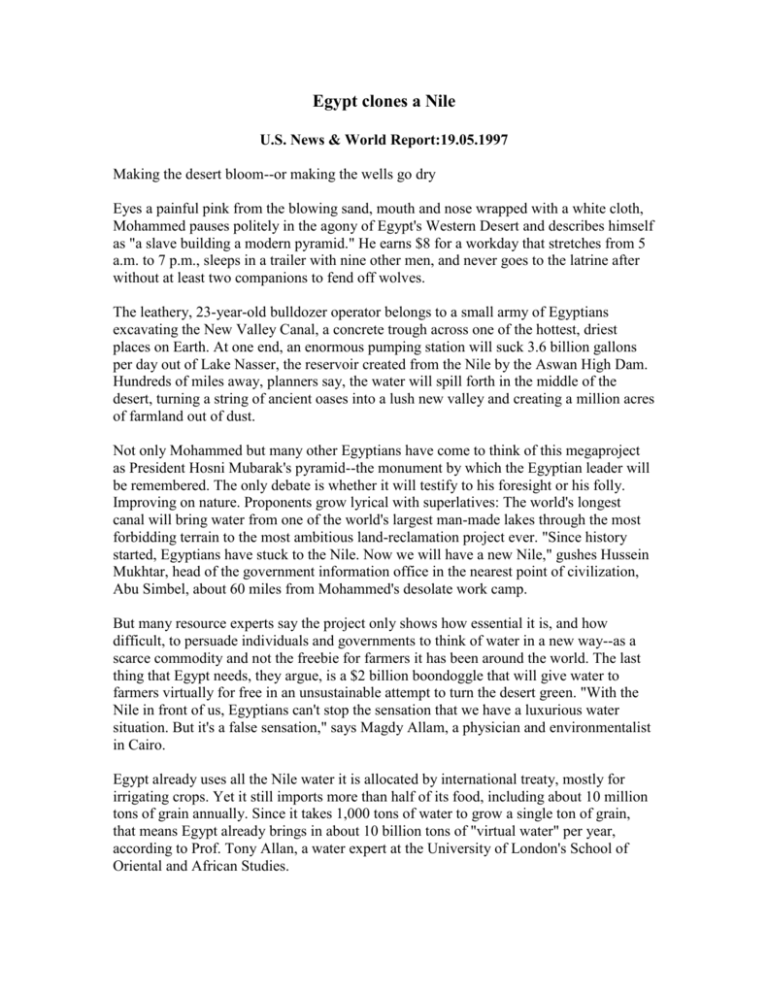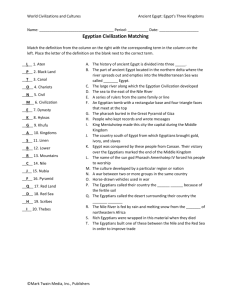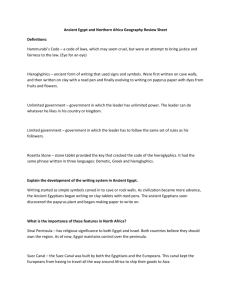
Egypt clones a Nile
U.S. News & World Report:19.05.1997
Making the desert bloom--or making the wells go dry
Eyes a painful pink from the blowing sand, mouth and nose wrapped with a white cloth,
Mohammed pauses politely in the agony of Egypt's Western Desert and describes himself
as "a slave building a modern pyramid." He earns $8 for a workday that stretches from 5
a.m. to 7 p.m., sleeps in a trailer with nine other men, and never goes to the latrine after
without at least two companions to fend off wolves.
The leathery, 23-year-old bulldozer operator belongs to a small army of Egyptians
excavating the New Valley Canal, a concrete trough across one of the hottest, driest
places on Earth. At one end, an enormous pumping station will suck 3.6 billion gallons
per day out of Lake Nasser, the reservoir created from the Nile by the Aswan High Dam.
Hundreds of miles away, planners say, the water will spill forth in the middle of the
desert, turning a string of ancient oases into a lush new valley and creating a million acres
of farmland out of dust.
Not only Mohammed but many other Egyptians have come to think of this megaproject
as President Hosni Mubarak's pyramid--the monument by which the Egyptian leader will
be remembered. The only debate is whether it will testify to his foresight or his folly.
Improving on nature. Proponents grow lyrical with superlatives: The world's longest
canal will bring water from one of the world's largest man-made lakes through the most
forbidding terrain to the most ambitious land-reclamation project ever. "Since history
started, Egyptians have stuck to the Nile. Now we will have a new Nile," gushes Hussein
Mukhtar, head of the government information office in the nearest point of civilization,
Abu Simbel, about 60 miles from Mohammed's desolate work camp.
But many resource experts say the project only shows how essential it is, and how
difficult, to persuade individuals and governments to think of water in a new way--as a
scarce commodity and not the freebie for farmers it has been around the world. The last
thing that Egypt needs, they argue, is a $2 billion boondoggle that will give water to
farmers virtually for free in an unsustainable attempt to turn the desert green. "With the
Nile in front of us, Egyptians can't stop the sensation that we have a luxurious water
situation. But it's a false sensation," says Magdy Allam, a physician and environmentalist
in Cairo.
Egypt already uses all the Nile water it is allocated by international treaty, mostly for
irrigating crops. Yet it still imports more than half of its food, including about 10 million
tons of grain annually. Since it takes 1,000 tons of water to grow a single ton of grain,
that means Egypt already brings in about 10 billion tons of "virtual water" per year,
according to Prof. Tony Allan, a water expert at the University of London's School of
Oriental and African Studies.
Seen as a whole, the Middle East is the world's largest exporter of oil--no surprise there-but also the largest importer of virtual water, a fact that many of its people and
governments do not seem to realize. "More water flows into the Middle East each year
embedded in grain than flows down the Nile to Egyptian farmers," Allan says. He
calculates that the Mideast "ran out of water"--became unable to feed its expanding
population with its limited water supplies--around 1972 and has been supplementing its
needs with imported virtual water ever since.
This has been relatively painless for Egypt and its neighbors because the United States,
Canada, and the European Union have long subsidized grain exports. During the 1980s,
the big grain producers sold wheat, on average, for $100 a ton when it would have cost
$200 a ton to produce without direct export subsidies, Allan says.
Liquid capital. But the price of virtual water is rising--grain hit $250 a ton last year—and
so are Middle Eastern water needs, mainly from rapid population growth. The result will
be a water crunch, with the ever present potential for conflict. A small reminder came last
week, when Jordan angrily canceled a meeting between Crown Prince Hassan and Israeli
Prime Minister Binyamin Netanyahu in a dispute over sharing water supplies.
Easing the crunch through desalination is no panacea. It can provide water for drinking
but is far too expensive for irrigating crops, the biggest use of water in the arid Mideast.
So Western advisers have been urging Arab countries to stop chasing the holy grail of
food self-sufficiency. Instead, the experts say, Mideast nations should import the grain
they need, banding together and using their muscle in the market to reduce the price.
Their own agriculture could then focus on crops that produce a high value per unit of
water, such as vegetables, and they should gradually raise the price of water to encourage
conservation and more efficient irrigation.
But it's a hard sell in many countries where food self-sufficiency remains a politically
popular goal. Saudi Arabia, for example, cultivates wheat in the desert with desalinated
water at an estimated seven times the world price per bushel. Jordan, which has the most
dire water shortage in the region, provides water to its farmers almost for free. Libyan
leader Muammar Qadhafi has spent $30 billion and more than a decade on a gargantuan
irrigation project, drilling thousands of deep wells through the desert into the Nubian
Sandstone Aquifer, a reservoir that was created during the Ice Age, more than 30,000
years ago, and has no source of replenishment. The result is what he calls "the Great
Man-Made River" but others have dubbed "the Great Madman's River" because it is
drawing down a precious, finite source of so-called fossil water. Fearing that Qadhafi will
deplete the ground water under both countries, Egypt plans to sink new wells of its own
to supplement the New Valley Canal. "No one knows exactly how much water is under
there, but it's like two people drinking with straws out of the same glass. It could
disappear pretty fast," says Nurit Kliot, a hydrogeologist at Israel's Haifa University.
So far, Israel is the only Middle Eastern country that has followed the prescription of
Western economists. In the 1960s, then Prime Minister Levi Eshkol and his cabinet
began reducing the amount of water available for agriculture. "It was a risky decision,
believe me, to abandon food security. But they took it," says Saul Arlosoroff, an Israeli
water expert and former World Bank executive. Israel gradually has raised the cost of
water for farmers to an average of 80 cents per 1,000 gallons, one of the highest rates in
the world for irrigation water. Israel no longer raises much of its wheat or meat,
concentrating on vegetables, fruits, and flowers. It is a leader in ultraefficient drip
irrigation, and 55 percent of its sewage water is treated and reused, mainly on inedible
crops such as cotton and flax.
But Egypt has many problems Israel does not, and Mubarak is pushing the New Valley
Canal not least as a way to deal with his country's overcrowding and unemployment.
Seen from above, Egypt is a vast arid plain with a thin green stripe--the Nile—running
down the middle. Ninety-five percent of Egypt's 60 million people are jammed onto that
stripe, just 5 percent of the land. Within two decades the population is expected to reach a
staggering 85 million, and it is hard to imagine where those additional 25 million people
will live or work, as the official unemployment rate hovers around 11 percent and
estimates of the actual rate top 20 percent. The government hopes to lure 7 million people
over the next 20 years to the New Valley with tax breaks, cheap land, and plenty of
water.
Egyptian planners say they can supply water to fill the canal by conserving 10 percent of
the country's current water usage. Repairing leaking pipes and lining ditches, using new
irrigation technology, and reducing the acreage of water-intensive crops such as rice,
cotton, and sugar cane would produce the needed savings.
But that extra supply of water and the jobs it is supposed to create exist only on paper,
even as the canal is under construction. Because water will continue to be provided at
little or no charge, farmers may find little or no incentive to conserve. Hopes for new jobs
may also be overblown. Mubarak's government says that private investors will build
export-oriented farms in the New Valley. But to be competitive, private exporters need to
use automated irrigation systems and hold down labor costs. "This project is going to
employ thousands of people, not millions," predicts Rushdi Said, an Egyptian
hydrogeologist with experience in desert farming. He and other critics believe it would be
wiser to halt urban encroachment on the Nile valley and delta and to build new industrial
cities around recently discovered coastal gas deposits.
Still, there is little doubt among Egyptians that Mubarak, Egypt's president since 1981, is
determined to go ahead with the project. "Egyptians are always looking for their
presidents and kings to do something with water," says Allam, the Cairo
environmentalist. Muhammad Ali, Egypt's great 19th-century pasha, built the first big
dam on the Nile as well as a canal from Cairo to Alexandria. Gamal Abdel Nasser built
the Aswan High Dam with Soviet help, and Anwar Sadat began the Peace Canal to bring
water to the Sinai.
Still unanswered is where Egypt will find $2 billion to build the canal and pumping
station, plus an additional $15 billion for roads, schools, and other infrastructure in the
New Valley. According to some reports, the oil-rich Sheik Zayed of Abu Dhabi, a major
donor to Egypt, may fund the canal and have it named in his honor. But "this has not
been determined," says Mahmoud Abu Zeid, president of the Egyptian National Water
Research Center. "If you contribute to the construction and reclaim 200,000 acres, we'll
name it after you."
© Copyright U.S. News & World Report, Inc. All rights reserved.










